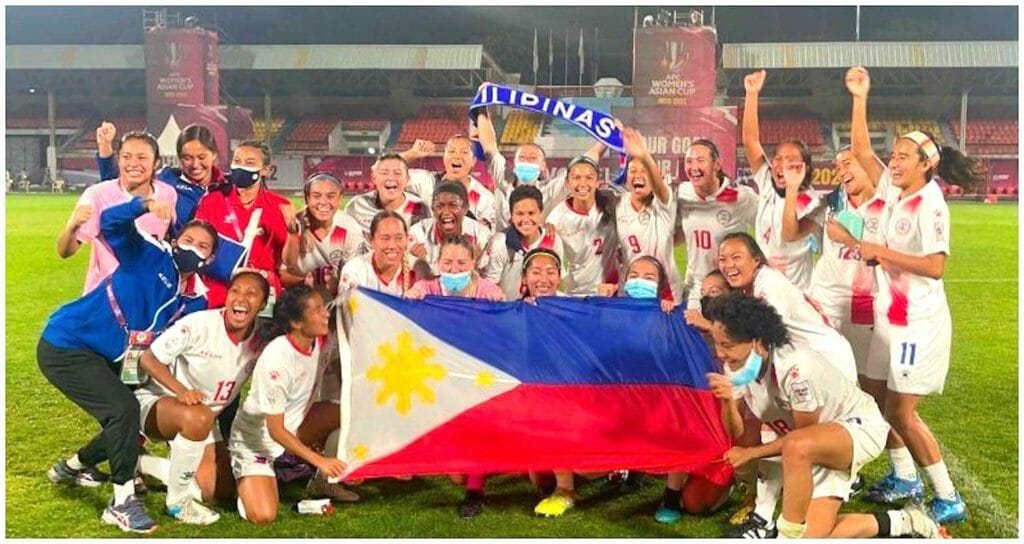
The Malditas Philippine National Women’s Soccer Team. INQUIRER FILE
NEW YORK—The fact that the Philippine women’s national football team—affectionately known as “Malditas” (Bad Girls)—qualified for the 2023 FIFA Women’s World Cup, the country’s first for a global tournament that is the most-watched, with an average audience of 3.3 billion people, made some question the Filipino-ness of the team. Their bone of contention? That a number of the players, being of mixed race and born abroad, didn’t fit their notion of what being Filipino (or Filipinx, to use the non-binary term) means.
Some of the soccer players pushed back. US-based goalie Kiara Fontanilla, whose parents are both Filipinos, declared, “We’re all Filipino, there’s no such thing as we’re not Filipino enough.”
Fil-American midfielder Malea Cesar chimed in. Grateful to connect with her Filipino roots, she said, “Being a part of this group and now seeing Filipino culture in the Philippines, it’s kind of surreal for me to see how welcoming everyone is.”
“This team has been more welcoming to me than any other group that I’ve experienced, and I know for me it’s because everyone here is Filipino and being able to connect with these girls on another level, a cultural level, isn’t something that I can do at home so being able to be here and seeing that experience brought to life in more than just the football team has been awesome for me.”
The team’s head coach Alen Stajcic expressed his disappointment. “When you see the players at training and how much passion they play with, how proud that they represent the flag, what they carry in their hearts—how can you doubt how much Filipino they are?”
Such a debate reflects other similar conversations and debates in the sports world, the most current being the case of 18-year-old Eileen Gu, the gold medalist at the Beijing 2022 Winter Olympics. Born in San Francisco, she chose to compete for the Republic of China rather than for the US. In conservative circles, she was impugned as being a “traitor” and “ungrateful,” that she wasn’t quite “American” having implicitly rejected the either/or binary identity for a more inclusive one. That Gu is comfortable accepting both identities is still a no-no for her critics.
Top-ranked professional tennis player Naomi Osaka, half African American and half Japanese, experienced similar criticism when she chose to compete under the Japanese flag but this quickly metamorphosed into adulation when she rose to become a tennis star.
There is quite a bit of confusion here, the naysayers mistaking racial purity with nationality, betraying a rather large gap in their understanding of history and of racial and national categories. During the Spanish colonial era that lasted for over 300 years, “Filipino” was applied only to Creoles, or those Spanish who were born in the islands. The Spanish who had come from the homeland didn’t care for the designation, preferring to be called “peninsulares” (those from the peninsula). In this snobbish hierarchy, the rest of the populace were simply “Indios,” with its undertones of racial inferiority.
However, by the 19th century, with a growing sense of commonality and an acknowledgement of a Hispanicized cum Christian background that cut across limited and limiting categories and spurred by Rizal and his fellow ilustrados “Filipino/a” would thenceforth be applicable to all the archipelago’s inhabitants, except for the Muslims, who had never identified with the Christian majority and resisted the incursions of the colonial state.
And so “Filipino/a” refers to a nationality, not to one’s race and/or ethnicity. Today, the range of Filipinoness is quite broad, in skin tone as well as in racial and ethnic matters, encompassing indigenous tribes, Tsinoys (Filipinos of Chinese descent), Malays, Spanish and Western mestizos, South Asians, Jews, etc. In a real sense we are the world.
What really lies at the heart of this ill-informed criticism is the quaint notion of the stereotypical Filipino/a that is constantly undercut by the nation’s racial and ethnic rainbow. At its most expansive and arguable interpretation, the naysayers might be said to reflect an anti-colonial sentiment. What is certainly true is that such views express a longing for a past and a purity that never was.
Copyright L.H. Francia 2022

